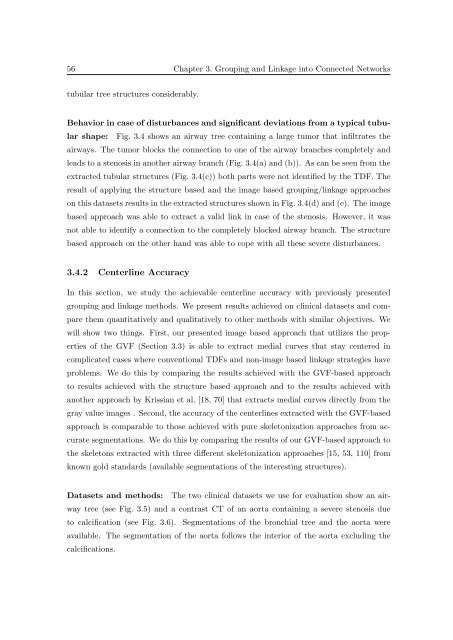Segmentation of 3D Tubular Tree Structures in Medical Images ...
Segmentation of 3D Tubular Tree Structures in Medical Images ...
Segmentation of 3D Tubular Tree Structures in Medical Images ...
You also want an ePaper? Increase the reach of your titles
YUMPU automatically turns print PDFs into web optimized ePapers that Google loves.
56 Chapter 3. Group<strong>in</strong>g and L<strong>in</strong>kage <strong>in</strong>to Connected Networks<br />
tubular tree structures considerably.<br />
Behavior <strong>in</strong> case <strong>of</strong> disturbances and significant deviations from a typical tubular<br />
shape: Fig. 3.4 shows an airway tree conta<strong>in</strong><strong>in</strong>g a large tumor that <strong>in</strong>filtrates the<br />
airways. The tumor blocks the connection to one <strong>of</strong> the airway branches completely and<br />
leads to a stenosis <strong>in</strong> another airway branch (Fig. 3.4(a) and (b)). As can be seen from the<br />
extracted tubular structures (Fig. 3.4(c)) both parts were not identified by the TDF. The<br />
result <strong>of</strong> apply<strong>in</strong>g the structure based and the image based group<strong>in</strong>g/l<strong>in</strong>kage approaches<br />
on this datasets results <strong>in</strong> the extracted structures shown <strong>in</strong> Fig. 3.4(d) and (e). The image<br />
based approach was able to extract a valid l<strong>in</strong>k <strong>in</strong> case <strong>of</strong> the stenosis. However, it was<br />
not able to identify a connection to the completely blocked airway branch. The structure<br />
based approach on the other hand was able to cope with all these severe disturbances.<br />
3.4.2 Centerl<strong>in</strong>e Accuracy<br />
In this section, we study the achievable centerl<strong>in</strong>e accuracy with previously presented<br />
group<strong>in</strong>g and l<strong>in</strong>kage methods. We present results achieved on cl<strong>in</strong>ical datasets and compare<br />
them quantitatively and qualitatively to other methods with similar objectives. We<br />
will show two th<strong>in</strong>gs. First, our presented image based approach that utilizes the properties<br />
<strong>of</strong> the GVF (Section 3.3) is able to extract medial curves that stay centered <strong>in</strong><br />
complicated cases where conventional TDFs and non-image based l<strong>in</strong>kage strategies have<br />
problems. We do this by compar<strong>in</strong>g the results achieved with the GVF-based approach<br />
to results achieved with the structure based approach and to the results achieved with<br />
another approach by Krissian et al. [18, 70] that extracts medial curves directly from the<br />
gray value images . Second, the accuracy <strong>of</strong> the centerl<strong>in</strong>es extracted with the GVF-based<br />
approach is comparable to those achieved with pure skeletonization approaches from accurate<br />
segmentations. We do this by compar<strong>in</strong>g the results <strong>of</strong> our GVF-based approach to<br />
the skeletons extracted with three different skeletonization approaches [15, 53, 110] from<br />
known gold standards (available segmentations <strong>of</strong> the <strong>in</strong>terest<strong>in</strong>g structures).<br />
Datasets and methods: The two cl<strong>in</strong>ical datasets we use for evaluation show an airway<br />
tree (see Fig. 3.5) and a contrast CT <strong>of</strong> an aorta conta<strong>in</strong><strong>in</strong>g a severe stenosis due<br />
to calcification (see Fig. 3.6). <strong>Segmentation</strong>s <strong>of</strong> the bronchial tree and the aorta were<br />
available. The segmentation <strong>of</strong> the aorta follows the <strong>in</strong>terior <strong>of</strong> the aorta exclud<strong>in</strong>g the<br />
calcifications.















